
We make the beds
About Us
Tasks & Goals
The VDFI represents the interests of the down and feather industry with the respect to politics, administration, and the public. The association tasks include: the provision of information, processing/analysing economical data, and a strong commitment to quality control and standardisation.
Members
The VDFI, the Association of the German Down and Feather industry, is the union of 25 industrial suppliers of down and feather filling as well as various components of the manufacturing of ready-made products.
Comfort, warmth, and ...
Down & Feathers
Things you need to know about down and feathers
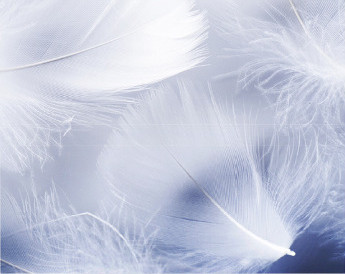
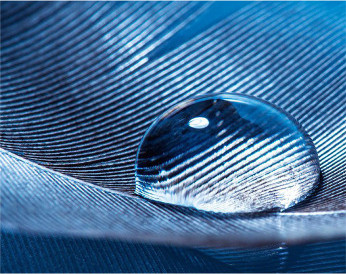
Down and feathers are marvelous things of nature. Questions about their origin, properties, applications and differences are explained in the following six points.
1. What is down?
Down looks similar to fine snowflakes. It is a 3-dimensional structure which has filaments growing uniformly from a barely visible core. These filaments retain a large amount of air. Down weighs only about 0.001-0.002 g. A kilo is comprised of 1/2 to 1 million individual down.
2. Where do down originate from?
Down form the undercoating of waterfowl, that is geese and ducks. Landfowl such as turkeys and chickens do not have any down. Down are growing beneath the covering plumage and can most frequently be found in the breast zone.
3. What are feathers?
Feather provides the exterior protections for the animal body. It is a flat, 2-dimensional structure and with soft filaments branching from the shaft which stems from the quill.
Goose Feather
The quill of an adult goose feather is blunt and around. The lower part of the feather has a rich fluff which becomes predominantly denser as it runs up the shaft.
Duck Feather
Duck feathers are strongly curved and graceful, which are radial from the top or tapper off.
4. What is the difference between down and feather?
Down and feather have a completely different structure. Down is a very distinct genus and is should not be confused with a young or small feather. They also do not develop like a feather. Down has no quill, but a point-like core, which makes it more elastic. Down is a 3-dimensional structure that is much lighter and fluffier than feathers. This structure allows for much more volume and filling capacity.
5. How can down, being such a light material, be such a good insulator?
Due to its 3-dimensional structure and its ability to regenerate, which allows the down to trap a large amount of air. A good down will have approximately 2 million fluffy down-filaments, which interlock. This forms a non heat-conducting layer, which protects against the cold. Because of its elasticity, down has the ability to restore to its original form by quickly shaking it.p>
6. Which fowl provides the best down?
Duck down is predominantly used in bedding and goose down is used in about one third of the products. The larger the down, the more air it may have, which provides for better insulation.
Viewing goose down under a microscope shows that it is slightly different but stronger structure when comparing it to duck down. This means with goose down you can include more air and therefore provided more filling capacity.
What means ... ?
Each branch has ist own technical terms and definitions.
Among other things, CEN (European body of standardization) developed the definition standard EN 1885 which defines the technical terms of the feather industry.
As follows the most important definitions of EN 1885.
The standard EN 1885, edition June 1998, which contains further definitions on the subject "down and feathers" can be obtained from:
British Standards Institution
Chiswick High Road 389
London W410772 Berlin
Telephone: 0044 / 208996 9000
Down
Plumage forming the undercoating of waterfowl, consisting of clusters of light, fluffy filaments growing from one scantly down core but without any quill shaft or vane.
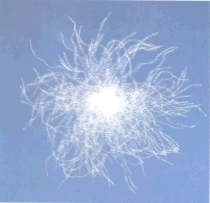
Feather
Horny integument of fowls. It has a shorter and softer vane than quill feather and, unlike plumules, a well developed quill.
Waterfowl feather
Feather derived from the plucking of waterfowl, such as ducks and geese.
Goose feather
Feather derived from the plucking of geese.
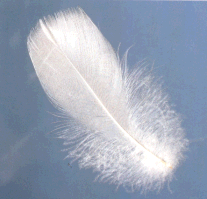
Duck feather
Feather derived from the plucking of ducks.
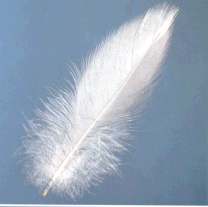
Down of Eiderduck
Down picked from eiderducks´ nests.
Landfowl feather
Feather derived from the plucking of landfowl, includes chicken feathers and turkey.
Finished feather
Feather which has been passed through all the working processes, including washing, drying and all hygienic treatments.
New feather
Feather not previously used after plucking as filling material.
Reprocessed feather
Feather which has been previously used as filling material and again subjected to treatment.
Feather extraction
VDFI e.V. is made up of 25 companies which produce and offer down- and feather-filled duvets/pillows as well as components for the manufacture of these items. For the purpose of sustainable business, the bedding industry processes down and feathers that are obtained as a by-product of poultry production.
The members condemn all forms of feather and down extraction from live animals which violate European law, and pledge not to procure filling materials from any procedure that inflicts pain upon animals. This obligation has been assumed by the companies as an additional stipulation in their purchase contracts and terms and conditions.
VDFI e.V. defines the following criteria for the recognition of supply chain traceability systems:
- The traceability of feathers and down shall be ensured back to the breeding farm, with the possibility of extending this to the parent farm if necessary.
- Through traceability, it is possible to identify and exclude feathers and down that have been obtained as a by-product of foie gras production.
- The supply chain shall be reviewed through announced and unannounced audits (at least every two years).
These criteria shall be periodically reviewed (at least every 2 years) by the General Assembly.
Sustainable Business – Making use of traceability
Given this situation, the work of the Association of the German Down and Feather industry is to document the harvesting of down and feathers. We regularly inform you about the current status.
In the VDFI 25 companies have come together. These companies produce and offer down and feather-filled duvets and pillows as well as other components of the produced products. The bed-feather industry, in terms of sustainable business, provide down and feather obtained as a by-product of poultry production.
The purpose of the traceability system is to document the association members beyond just their purchases of down and feathers. Regular audits are carried out by independent testing and certification organizations. The business practices of the companies are also checked regularly.
What is EN 12934 ?
1. Field of application of EN 12934
The standard establishes provisions for the labelling of the components of plumage for use as fillings (down, feather, other elements) and of fowl species (waterfowl or landfowl).
It is applicable to finished feathers and down.
This standard is not applicable for fillings totally containing more than 0,5% of foreign matter.
2. Scope
Represenatives from 18 European countries have prepared the standard headed by the European Committee for Standardization (Comitee Européne de Normalisation -CEN).
Austria, Belgium, Czech Republic, Denmark, Finland, France, Germany, Greece, Ireland, Italy, Luxembourg, Netherlands, Norway, Portugal, Sweden, Switzerland, Spain, and the United Kingdom are bound to comply with the standard.
3. Aim
EN 12934 lays down labeling of filling consisting of down and feathers, and is the first and only labeling standard prepared by and for all EU and EFTA states.
4. What is especially important for correct labelling?
- The feathers and down are "new", i. e.they have not been used as filling material before (the percentage of other elements does not exceed 5%, whitch is decisive for classification of the material).
- Only pure waterfowl fillings (goose and duck) qualify for labelling in classes I, II or III.
- The down and feather percentage shall be indicated on the label.
4.1 "New" fillings
A filling can only be labelled as "new", if the filling does not contain reprocessed feathers and down. Only fillings containing "new" feathers and down may be labelled as "new". Among other things, reprocessed feathers and down in a filling are perceptible by a high percentage of "other elements" (down fibres, feather fibres, reprocessed feathers and down, residual).
EN 12934 classifies fillings belonging to class I and IV as "new", since a percentage of other elements less than 5 % suggests that these fillings contain "new" feathers and down.
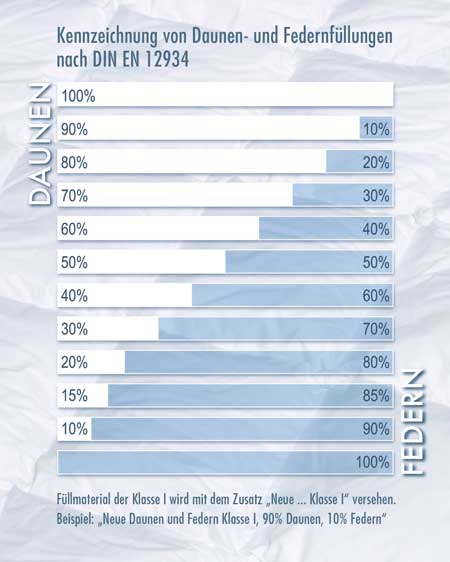
4.2 Waterfowl and/or Landfowl Filings
The filling material is classified by means of percentage of other elements.
| Percentage of other elements (%) | Classification | Components and composition | |
|---|---|---|---|
| Waterfowl fillings (Goose and duck) | up to 5 | "class I" and/or "new" | Down ...% Feather ...% |
| more than 5 to 15 | "class II" | Down ...% Feather ...% |
|
| more than 15 | "class III" | Down ...% Feather ...% other elements ...% |
|
| Fillings consisting of landfowl or Land- and waterfowl | up to 5 | "class IV" and/or "new" | Down ...% Feather ...% |
| more than 5 to 15 | "class V" | Down ...% Feather ...% |
|
| more than 15 | "class VI" | Down ...% Feather ...% other elements ...% |
|
| "class VII" | (unspecified composition) |
4.3.1 Classification of the material
A filling material is classified according to its percentage of other elements. Thus, for instance waterfowl filling material with a percentage of other elements (broken feathers, fibres) not exceeding 5% may be labelled as class I. In this case it is also permissible to indicate "new" on the label.
Waterfowl fillings with a percentage of other elements between 5% and 15% may be labelled as class II. On account of the high percentage of other elements it is assumed that the filling contains considerable percentages of material that has previously been used. Fillings belonging to classes II and III may not be labelled as "new".
Waterfowl fillings labelled as class III with a percentage of other elements exceeding 15% indicate a considerable content of fillings previously used as filling material. In this case, it is mandatory to disclose the percentage of other elements on the label - rounded to the nearest 10 %.
4.3.2 Down and feather percentages
The content of down and feathers of a filling shall mandatorily been indicated on the label, stated in groups to rounded 10 % in decreasing order, except for blends with 85 % feathers and 15 % down.
5. May the fowl species be indicated on the label?
See following points ...
5.1 Waterfowl
The labelling of species is OPTIONAL. The denomination "Waterfowl" may be used in the labelling. The actual waterfowl species (duck and goose) may als o be labelled according to the following chart.
Waterfowl species - Examples for appropriate labelling in correspondence with percentages
| Percentage(s) Composition | Denominations | |||
|---|---|---|---|---|
| 100 | to | 90,0 | Goose | pure Goose |
| 0 | to | 9,9 | Duck | |
| 89,9 | to | 70 | Goose | Goose |
| 10 | to | 29,9 | Duck | |
| 69,9 | to | 50 | Goose | Goose / Duck |
| 30 | to | 49,9 | Duck | |
| 69,9 | to | 50 | Duck | Duck / Goose |
| 30 | to | 49,9 | Goose | |
| 99,9 | to | 70 | Duck | Duck |
| 10 | to | 29,9 | Goose | |
| 100 | to | 90 | Duck | pure Duck |
| 0 | to | 9,9 | Goose | |
This is also applicable to class II.
5.2 Landfowl
The labelling of species is OPTIONAL. The denomination "Landfowl" may be used in the labelling. The actual landfowl species (chicken and turkey) may also be labelled.
5.3 Blends of land- and waterfowl species: neccessary and possible indications
With blends of land- and waterfowl species the label shall disclose the denominations "landfowl" and/or "waterfowl" in accordance with the following c hart:
Blends of land- and waterfowl species
| Percentage(s) composition | Percentage(s) composition | |||
|---|---|---|---|---|
| 100 | to | 90 | Landfowl | Landfowl |
| 0 | to | 9,9 | Waterfowl | |
| 89,9 | to | 50 | Landfowl | Landfowl / Waterfowl |
| 89,9 | to | 50 | Landfowl | Landfowl / Waterfowl |
| 10 | to | 49,9 | Waterfowl | |
| 89,9 | to | 50 | Waterfowl | Waterfowl / Landfowl |
| 10 | to | 49,9 | Landfowl | |
| 100 | to | 90 | Waterfowl | Waterfowl |
| 0 | bis | 9,9 | Landfowl | |
The fillings shall be labelled according to its plumage content of fowl species in decreasing order and shall be rounded to the nearest 10 %.
6. Labelling according to EN 12934
Recommendation for the structure of the label.
| Color | Origin | New | Fowl species | Class | Percentage of the filling weight, percentage of the components* |
|---|---|---|---|---|---|
| white | Hungarian | new | Waterfowl down and feathers | Class I | 60% Down 40% Feathers |
Alternative
| Color | Origin | New | Fowl species | Class | Percentage of the filling weight, percentage of the components* |
|---|---|---|---|---|---|
| white | Hungarian | new | Goosedown and feathers | Class I | 60% Down 40% Feathers |
*only this information is a labelling requirement. The other information is optional
This filling consists of material which has not previously been used and may be composed of:
- 60% Goose down
- 40% Goose feathers
Disposal
Through professional preparation down and feathers can be re-used. Therefore, they can be found, for example, in the cushions of furniture. Also once they have been worn out, they can be used as environmentally friendly fertilizer.
Studies were conducted at the University of Hohenheim for "use of feather meal as organic nitrogen fertilizer in agriculture and horticulture", where the nutrient content of feather meal, horn meal and manure were comparatively investigated.
Comparison of Feather Meal, Horn Meal and Manure
| Feather meal | Horn meal | Manure | |
|---|---|---|---|
| org. Substance (C) | 45% | 70% | 18% |
| Nitrogen | 14% | 10% | 1,7% |
| Other main nutrients (g/KG TS) | |||
| Phosphorus | 2,9 | 1,8 | 2,5 |
| Potassium | 1,5 | 1,2 | 5,0 |
| Magnesium | 0,8 | 0,3 | 1,5 |
Down and feathers that are worn out can be used as an excellent nitrogen fertilizer, which can be used in planters and flower beds, even for private use.
The microorganisms in the soil decompose the feathers so that their components can be absorbed by plants.
Rest, relax, and ...
Sleep Better
... under duvets in the right size
Duvets are available in different sizes - but which size is best? The standard sizes for duvets have changed over the last fifty years. This is partly due to the increased height of the buyer, but also to the desire for more comfort. Until 1950, the production was still done mainly by hand, then because of increasing industrialization more uniform and precise measurements were established.
The standard width measurements of a duvet are now 135, 155, or 200cm, where their length measurements are 200 or 220 cm. Various combinations are available; however, the default size is 135 x 200 cm. A sufficient size, for a person with the height of 180 cm, is 135 x 200, but for more comfort, we recommend 155 X 220. The sizes of 135 x 220 and 155 x 200 are being purchased less frequently today and the size 155 x 220 is becoming increasingly more important.
Pillows are available in hundreds of variants. The classic measurement is 80 x 80 cm. A narrow version is available for optimal support of the neck and spine. Generally, only the head should be on the pillow - not the shoulder. A high portion of feathers gives the cushion a special supporting force. It is best to try various kinds and see what suits you best.
Duvets for single beds
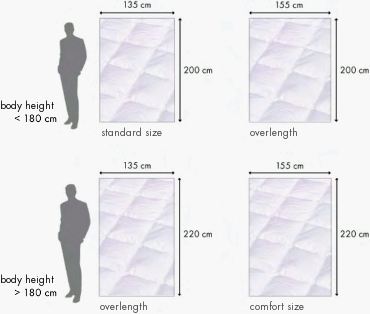
Duvets for double beds
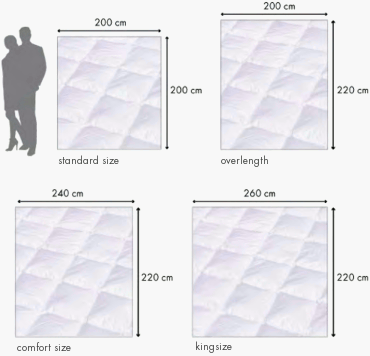
... with the appropriate temperature class
How do you sleep? In heated bedroom or even with the windows open during the winter months? Are you looking for a light summer blanket or extra warm winter bed? Would like an an all-year blanket? Or what about one for a transition bed?
In addition to the dimensions, it is important to consider the appropriate temperature class or heat category most suitable for you. This demands on your own sleeping preferences and room conditions. Different manufactures share commonalities with different temperature classes. You are able to find corresponding information and instructions on the products about this. Different temperature classes are described here:
Heat category 1 - Suitable for very warm bedrooms and a (slight) summer bed - for sleepers with very gentle warmth requirements
Heat category 2 - For slightly heated rooms and for warmer transition temperatures
Heat category 3 - For cooler transition temperatures and as a year-round cover, for normal temperature-controlled bedrooms and normal warmth requirements
Heat category 4 - For cold rooms and for winter blankets with higher heat requirement
Heat category 5 - extra warm winter blankets for cold bedrooms and with a very high heat requirement
... in a comfortable sleeping climate
First you want to selection of the correct dimension, temperature class and filling of your duvet. Then you want to determined the appropriate pillow, which provides the best support for your neck and shoulders. In addition, your quality of your sleep can be affected by the decor and layout of your room so try and have an appropriate layout. Then waking up refreshed and well rested is no obstacle.
Several aspects of dust mite allergies should especially be taken into account. The best strategy for prevention of unpleasant allergic symptoms, of course, is avoiding allergy triggers.
- Having suitable plastic rug mats or good wipe-able coverings for the floors
- Avoid upholstered bed fabrics.
- Choose curtains with materials that are easily washable.
- Furnish with mattresses with mite-proof covers.
- Wash bedding weekly in 60-95 ° C. Incidentally, feather and down bedding can be washed according to the care instructions and can be tumble dried.
- Pay attention to the suitable selection of bedding for house dust mite allergies: NOMITE® products, for example, are suitable for house dust mite allergy sufferers.
- Wash stuffed animals regularly at 60 ° C or put them in the fridge for up to 2 days in order to kill the dust mites.
- Ventilate bedrooms regularly and try not to heat the room too much. Also try to avoid undressing in the bedroom because it can increase dander. Dander is the source of food for dust mites.
... without heat accumulation
Whether a sleeper feels good in bed or not, is largely determined by the climate in the bed.
The insulating effect of a blanket depends primarily on
- the filling material (for example, down and feathers)
- the filling quantity (in grams)
- Construction materials/process (for example, workmanship of the inner webs and geometry of the stitching)>
- the Bausch behavior, i.e. the ability of the filling to bind with the air, as this air cushion is extremely important for the insulation capacity of the blanket.
- the conformability (i.e., the blanket has the ability to adapt to the shape of the sleeper and his/her movements)
Down and feather filled bedding can be individually prepared to specific needs of the sleeper. Adjusting to an appropriate room temperature to accommodate the heat radiation of the body and the movement during sleep. Also by varying the blanket’s height, the fill weight, the stitching, the bed can be "tailored" to your needs.
The ambient temperature and the room temperature should also be considered depending on the seasonal temperature. The requirements of the blanket for the respective sleeper are crucial. For example: People who get cold easily in the winter months should definitely consider a warmer duvet, where in the summer months, a lighter duvet should be considered.
... with perfect care
Down and feather beds are grateful and frugal. In dry weather, close to an open window, they are sure to last and retain their functionality to provide a restful sleep.
The filling is loosened, and new air spaces are created. Air also ensures the removal of overnight moisture.
Down and feathers are not afraid of water; however, please pay attention to a thorough drying!
Never place Bedding in sunshine.
Tapping and vacuuming are taboo!
The cleaning of the filling can be done in bed specialist shops. The duvet and the pillow can be machine washed and then dried in a sufficiently large dryer. Please note the care instruction labels, which are located on the bed piece.
... ... with dust allergy sufferers in mind
NOMITE® pillow shams and duvet covers for down-filled and feather-filled bedding goods feature a special weave with superb feather-proof and down-proof properties, particularly with dust allergy sufferers in mind. Laboratory research has revealed that there is no connection between down-filled and feather-filled bedding goods and large- or small-scale house dust mite occurrence. In all cases, few or none of these arachnids were present in the bedding goods examined..
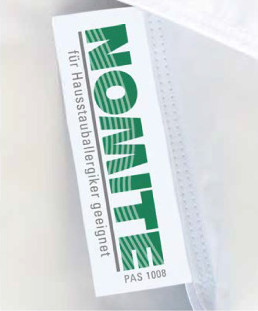
It is not the house dust mite itself that prompts the allergic reaction, but, rather, its faeces, and this only in the event of large-scale occurrence. The presence of a few house dust mites is, in terms of allergenic effect, insignificant. House dust mites occur in every home, as they prefer the same environmental conditions as humans. For this reason, it is quite difficult entirely to exterminate them without making substantial sacrifices in one own living quality. As only large-scale infestation is a reason for concern, the research carried out began with an investigation into what can lead to large-scale infestation.
Nourishment
House dust mites feed primarily on the skin flakes and dandruff of humans and their pets. Each day, we produce between ca. 0.5 and 1 g of skin flakes and dandruff, of which 0.25 g is already enough to nourish several thousand of the creatures. Feathers and down do not however form part of their diet, as demonstrated in laboratory experiments.
Conclusion: It is not down or feathers that nourish house dust mites, but human beings.
Textile barrier
Interestingly enough, the research into house dust mites and bedding goods revealed that these creatures are indeed too large to penetrate the ticking of down and feather bedding-goods. While featuring optimum climate and air exchange, such ticking is so densely woven that it is impossible for fine down to find a way out of it.
The technical term for this is: ‘down proof.’ Further, house dust mites have no ‘reason’ to penetrate through ticking to feed on feathers. What’s more, down-proof ticking is an additional barrier, that prevents them from migrating into the interior of bedding goods.
A definite ‘Yes’ to down and feathers
Those with a house dust mite allergy also deserve to enjoy the advantages and comfort of down and bedding goods containing feathers, without regrets. As research has shown, there are two reasons why there is virtually no occurrence of house dust mites in down and feather bedding-goods: Firstly, because they obtain their nourishment primarily from skin flakes and dandruff, not from feathers and down, so that they have no ‘reason’ to penetrate ticking. And secondly, because they are unable to break through the textile barrier formed by down-proof weaves.
Learn more at www.nomite.de
Service, closeness, and ...
Information
Here you can download brochures and various movies free of charge, all about feathers and down.
The Information Leaflet concentrating on ”Bedding Articles for House-Dust-Mite Allergic Sufferers – Nomite“
Please click at the icon to start the download.
Production
Production film introduction.
Maintenance
Maintenance film introduction.
A Collection of Informative Materials for House-Dust-Mite Allergy Sufferers
“Good News for Allergy Sufferers”
„Scientific studies, expert opinion and publications of the topic of down- and feather-filled bedding articles and house-dust-mite allergy”
Flyers
Information package for house dust mite allergy sufferers
„Good news for allergy sufferers“
„Scientific studies, professional opinion and publications in the field of duvets and house dust mite allergy “
Information can be downloaded directly free of charge.
Information brochure „Bedding for house dust mite allergy sufferers – Nomite“
The flyer is ready for download.
Films
Maintenance
Production
Animated movie "Natürlich Träumen"
Film de production (en français)
NOMITE film
NOMITE 2015
Movement, innovation, and ...
Press
Positive review: Economic monitor of the German down and feather industry
Covid, Sustainability und expanded online business as source of revenue Idea of the circular economy guides product...
1 year with COVID 19: Turnover of the German down and feather industry...
Short-time work and tax deferrals Winners in the crisis: online sales channels Survey update on the economic...
Sustainable management - making the use of goods traceable
This is the maxim of VDFI e. V.'s (German Down and Feather Association) work of the documentation of the winning...
VDFI publishes a movie about the production process in a bedfeather plant
From the raw material to the down duvet - the new movie of the VDFI e. V. shows the production processes in...

Do you have any questions regarding the association or concerning the membership?
Verband der Deutschen Daunen- und Federnindustrie e.V.
55122 Mainz



